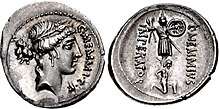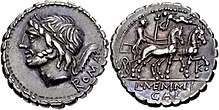Memmia (gens)
The gens Memmia was a plebeian family at Rome. The first member of the gens to achieve prominence was Gaius Memmius Gallus, praetor in 172 BC. From the period of the Jugurthine War to the age of Augustus they contributed numerous tribunes to the Republic.[2]
Origin
The poet Vergil linked the family of the Memmii with the Trojan hero Mnestheus. This late tradition suggests that by the end of the Republic, the gens had become a conspicuous part of the Roman nobility.[2] The nomen Memmius is classified by Chase with those gentilicia that either originated at Rome, or cannot be shown to have come from anywhere else. From its morphology, the name could be derived from a cognomen, Memmus, the significance of which is unknown.[3] The use of Quirinus, a Sabine deity, on the denarii of Gaius Memmius in 56 BC, perhaps alludes to a Sabine origin of the gens.[4]
Praenomina
The main praenomina of the Memmii were Gaius, Lucius, Quintus, and Publius. There is also at least one example of Titus.
Branches and cognomina
The Memmii of the Republic do not appear to have been divided into distinct families, but they used a number of personal surnames, including Quirinus, thought to have been the name of a Sabine god, who came to be equated with both Janus and Romulus; Gallus, referring to a cockerel, or perhaps to a Gaul; and Geminus, traditionally given to a twin.[5] Other cognomina are found in imperial times, including Maximus, given to an eldest brother, or someone particularly notable; Regulus, a diminutive of rex, a king, used by a number of old Roman families; Pollio, a polisher, particularly of armour; Afer, referring to the province of Africa; and Senecio, a diminutive of senex, an old man.[6][7]
Members
- This list includes abbreviated praenomina. For an explanation of this practice, see filiation.
- Gaius Memmius C. f. Quirinus, plebeian aedile prior to 210 BC, was the first to exhibit the Cerealia at Rome.[8][9]
- Gaius Memmius Gallus, praetor in 172 BC, obtained Sicily as his province.[10][8][11]
- Titus Memmius, commissioner sent by the senate to hear the complaints of the Achaeans and Macedonians against the Roman magistrates, in 170 BC.[12][13]
- Quintus Memmius, legate sent by the senate to the Jews circa 164 BC.[8][14][15]
- Lucius Memmius C. f., a senator in 129 BC, perhaps the son of Gaius Memmius, the praetor of 172. He was probably the senator who visited Egypt in 112 BC.[16][17][18]
- Gaius Memmius, nicknamed Mordax, was tribune of the plebs in 111 BC. A candidate for the consulship in 100, he was bludgeoned to death by the supporters of Lucius Appuleius Saturninus and Gaius Servilius Glaucia.[8][19][20][21][22][23][24][25]
- Lucius Memmius, triumvir monetalis circa 109 BC, brother of Gaius Memmius, the tribune of the plebs of 111. Cicero describes them as mediocre but aggressive orators. He was also a supporter of Marcus Livius Drusus and his daughter married Gaius Scribonius Curio, the consul of 76.[26][27][28][29]
- Lucius Memmius, triumvir monetalis in 106 BC, pictured Venus on his denarii, an allusion to the gens' claim of Trojan descent.[lower-roman 1][8][1]
- Gaius Memmius L. f., triumvir monetalis in 87 BC, together with his brother, Lucius.[lower-roman 2][30]
- Lucius Memmius L. f., triumvir monetalis in 87 BC, together with his brother, Gaius.[30]
- Gaius Memmius (C. f.), married a sister of Gnaeus Pompeius, under whom he served in Sicily in 81 BC, and later in Hispania, where he died in 75. He was probably the son of Gaius Memmius, the tribune of 111.[8][31][32][33][34]
- Publius Memmius, a witness for the defense at the trial of Aulus Caecina in 69 BC.[8][35]
- Gaius Memmius L. f. Geminus, son of Lucius Memmius, the triumvir monetalis of 109 BC, was an eloquent speaker and poet. He was tribune of the plebs in 66 BC, praetor in 58, and propraetor in Bithynia and Pontus the following year. He was the first husband of Fausta Cornelia, the daughter of Sulla.[8][36][34]
- Gaius Memmius C. f. L. n., triumvir monetalis in 56 BC, tribune of the plebs in 54 BC, prosecuted various officials for corruption; he was consul suffectus in 34 BC, and exhibited games in honour of Venus Genetrix.[8][37][38][39][40][34][4]
- Lucius Memmius C. f. L. n., of the tribe Galeria, a tribune of the plebs at an uncertain date, distributed lands to the veterans of the 7th and 26th legions in 41 BC.[41][42]
- Publius Memmius P. f. Regulus, consul suffectus ex Kal. Oct. in AD 31, and subsequently governor of Macedonia, was the first husband of Lollia Paullina, afterwards the empress of Caligula, who compelled them to divorce so that he could marry her.[8][43][44][45][46]
- Lucius Memmius Pollio,[lower-roman 3] consul suffectus in AD 49.[8][47][48]
- Gaius Memmius Regulus, probably the son of Publius Regulus and Lollia Paullina, was consul in AD 63.[8][49][50][51][46]
- Senecio Memmius Afer, consul suffectus in AD 99.
- Lucius Memmius Tuscillus Senecio, son of the consul of AD 99.[52]
- Quintus Aurelius Memmius Symmachus, consul in AD 485.
Footnotes
- ↑ The legend GAL on his coins refers to his tribe, Galeria, and is not a cognomen; he used it to distinguish himself from Lucius Memmius, the moneyer of 109.
- ↑ Evidently the sons of Lucius Memmius, the moneyer of 106, since they reused the design of his coins, as well as mentioning the tribus Galeria.
- ↑ Or possibly Mammius.
See also
References
- 1 2 Crawford, Roman Republican Coinage, pp. 320-321.
- 1 2 Dictionary of Greek and Roman Biography and Mythology, vol. II, p. 1026 ("Memmia Gens").
- ↑ Chase, p. 131.
- 1 2 3 Crawford, Roman Republican Coinage, pp. 451, 452.
- ↑ Chase, pp. 111, 114.
- ↑ Chase, pp. 111, 112, 116.
- ↑ New College Latin & English Dictionary, s. v. Afer, senex.
- 1 2 3 4 5 6 7 8 9 10 11 12 Dictionary of Greek and Roman Biography and Mythology, vol. II, pp. 1026, 1027 ("Memmius").
- ↑ Broughton, vol. I, pp. 273, 277 (note 4).
- ↑ Livy, xlii. 9, 10, 27.
- ↑ Broughton, vol. I, p. 411.
- ↑ Livy, xliii. 5.
- ↑ Broughton, vol. I, p. 421.
- ↑ First Book of Maccabees, ii. 11.
- ↑ Broughton, vol. I, p. 439.
- ↑ Broughton, vol. I, p. 539.
- ↑ Sherk, "Senatus Consultum De Agro Pergameno", p. 367.
- ↑ Select Papyri, 2.416.
- ↑ Sallust, Bellum Jugurthinum, 27, 30–34.
- ↑ Cicero, De Oratore, ii. 59, § 240, 66, § 267, 70, Pro Fonteio, 7, In Catilinam, iv. 2.
- ↑ Appian, Bellum Civile, i. 32.
- ↑ Livy, Epitome 69.
- ↑ Florus, iii. 16.
- ↑ Quintilian, vi. 3. § 67.
- ↑ Broughton, vol. I, pp. 541, 559.
- ↑ Sisenna, fr 44.
- ↑ Cicero, Brutus, 36, 70, 89, Pro Sexto Roscio, 32.
- ↑ Wiseman, 1967, p. 166.
- ↑ Crawford, Roman Republican Coinage, p. 315.
- 1 2 Crawford, Roman Republican Coinage, pp. 363–364.
- ↑ Cicero, Pro Balbo, 5.
- ↑ Plutarch, "The Life of Pompeius", 11, "The Life of Sertorius", 21.
- ↑ Orosius, v. 23.
- 1 2 3 Wiseman, 1967, p. 167.
- ↑ Cicero, Pro Caecina, 10.
- ↑ Broughton, vol. II, p. 153.
- ↑ Cicero, Epistulae ad Quintum Fratrem, iii. 1, 5, 15, 2, 1, 3, 2, Pro Rabirio Postumo, 3.
- ↑ Valerius Maximus, viii. 1. § 3.
- ↑ Cassius Dio, xlix. 42.
- ↑ Broughton, vol. II, pp. 223, 410.
- ↑ ILS 887
- ↑ Crawford & Wiseman, pp. 156, 157.
- ↑ Cassius Dio, lviii. 9, lix. 12.
- ↑ Tacitus, Annales, xii. 23, xiv. 47.
- ↑ Suetonius, "The Life of Caligula", 25.
- 1 2 PIR, vol. II, p. 364.
- ↑ Tacitus, Annales, xii. 9.
- ↑ PIR, vol. II, p. 327.
- ↑ Fasti Capitolini.
- ↑ Tacitus, Annales, xv. 23.
- ↑ Gruter, p. 8.
- ↑ CIL XIV, 3597.
Bibliography

- Lucius Cornelius Sisenna, Historiae.
- Marcus Tullius Cicero, Brutus, De Oratore, Epistulae ad Quintum Fratrem, In Catilinam, Pro Balbo, Pro Caecina, Pro Fonteio, Pro Gaio Rabirio Postumo.
- Gaius Sallustius Crispus (Sallust), Bellum Jugurthinum (The Jugurthine War).
- Titus Livius (Livy), History of Rome.
- Valerius Maximus, Factorum ac Dictorum Memorabilium (Memorable Facts and Sayings).
- Marcus Fabius Quintilianus (Quintilian), Institutio Oratoria (Institutes of Oratory).
- Publius Cornelius Tacitus, Annales.
- Plutarchus, Lives of the Noble Greeks and Romans.
- Gaius Suetonius Tranquillus, De Vita Caesarum (Lives of the Caesars, or The Twelve Caesars).
- Lucius Annaeus Florus, Epitome de T. Livio Bellorum Omnium Annorum DCC (Epitome of Livy: All the Wars of Seven Hundred Years).
- Appianus Alexandrinus (Appian), Bellum Civile (The Civil War).
- Lucius Cassius Dio Cocceianus (Cassius Dio), Roman History.
- Paulus Orosius, Historiarum Adversum Paganos (History Against the Pagans).
- Jan Gruter, Inscriptiones Antiquae Totius Orbis Romani (Ancient Inscriptions from the Whole Roman World), Heidelberg (1603).
- Dictionary of Greek and Roman Biography and Mythology, William Smith, ed., Little, Brown and Company, Boston (1849).
- George Davis Chase, "The Origin of Roman Praenomina", in Harvard Studies in Classical Philology, vol. VIII, pp. 103–184 (1897).
- Paul von Rohden, Elimar Klebs, & Hermann Dessau, Prosopographia Imperii Romani (The Prosopography of the Roman Empire, abbreviated PIR), Berlin (1898).
- T. Robert S. Broughton, The Magistrates of the Roman Republic, American Philological Association (1952).
- Michel Crawford & Timothy Peter Wiseman, "The Coinage of the Age of Sulla", in The Numismatic Chronicle and Journal of the Royal Numismatic Society, Seventh Series, Vol. 4 (1964), pp. 141–158, Appendix II, pp. 156, 157.
- Robert K. Sherk, "The Text of the Senatus Consultum De Agro Pergameno", in Greek, Roman, and Byzantine Studies, vol. 7, pp. 361–369 (1966).
- T. P. Wiseman, "Lucius Memmius and His Family" in Classical Quarterly, Vol. 17, No. 1 (May 1967), pp. 164–167.
- John C. Traupman, The New College Latin & English Dictionary, Bantam Books, New York (1995).
- Michael Crawford, Roman Republican Coinage, Cambridge University Press (1974, 2001).

